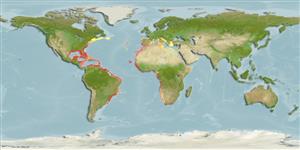Klassifizierung / Names
Namen | Synonyme | Catalog of Fishes (gen., sp.) | ITIS | CoL | WoRMS | Cloffa
Actinopterygii (Strahlenflosser) >
Perciformes (Perch-likes) >
Carangidae (Jacks and pompanos) > Caranginae
Etymology: Caranx: French, carangue, the name of a Caribbean fish; 1836 (Ref. 45335).
Lebensraum / Klimazone / Range
Ökologie
; seewasser; brackwasser riff-verbunden; ozeanodrom (Ref. 51243); tiefenbereich 1 - 350 m (Ref. 7097), usually 1 - 200 m (Ref. 55173). Subtropical, preferred 27°C (Ref. 107945); 45°N - 33°S, 98°W - 14°E
Eastern Atlantic: Portugal to Angola, including the western Mediterranean. Western Atlantic: Nova Scotia, Canada and northern Gulf of Mexico to Uruguay (Ref. 7251), including the Greater Antilles (Ref. 9626). Absent from eastern Lesser Antilles (Ref. 26938). Indian Ocean records are probably misidentifications of Caranx ignobilis. Reports from Pacific refer to Caranx caninus, which may be conspecific.
Length at first maturity / Size / Gewicht / Alter
Maturity: Lm 66.0 range ? - ? cm
Max length : 124 cm TL Männchen/unbestimmt; (Ref. 5217); common length : 75.0 cm TL Männchen/unbestimmt; (Ref. 2683); max. veröff. Gewicht: 32.0 kg (Ref. 27584)
Rückenflossenstacheln (insgesamt): 9; Rückenflossenweichstrahlen (insgesamt): 19-22; Afterflossenstacheln 3; Afterflossenweichstrahlen: 15 - 18. Diagnosis: Scutes on lateral line 23 (Ref. 57392) to 42 (Ref. 13442). No scales on chest (Ref. 13442), except a small mid-ventral patch in front of pelvic fins (Ref. 13442, 57392). Upper profile of head steep (Ref. 13442). Maxilla ending approximately below (Ref. 13442, 57392) or beyond (Ref. 57392) posterior edge of eye (in adult). Front of soft dorsal and anal fins elevated; olivaceous to bluish green dorsally, silvery to brassy on the sides; prominent black spot posteriorly on gill cover at level of eye, another at upper axil of pectoral fins, and often a third on lower pectoral rays; caudal yellowish (Ref. 13442).
Generally in neritic waters over the continental shelf (Ref. 5217), from the coastline, where it is common on shallow flats, to offshore waters (Ref. 57392). Adults ascend rivers (Ref. 26938). Juveniles abundant in brackish estuaries with muddy bottoms, near sandy beaches and on seagrass beds (Ref. 5217), entering lagoons and lower courses of rivers (Ref. 57392). They form fast-moving schools, although larger fish may be solitary. They feed on smaller fish, shrimp, and other invertebrates (Ref. 5521). Often grunts or croaks are heard when caught. Eggs are pelagic (Ref. 4233).
Smith-Vaniz, W.F., J.-C. Quéro and M. Desoutter, 1990. Carangidae. p. 729-755. In J.C. Quero, J.C. Hureau, C. Karrer, A. Post and L. Saldanha (eds.) Check-list of the fishes of the eastern tropical Atlantic (CLOFETA). JNICT, Lisbon; SEI, Paris; and UNESCO, Paris. Vol. 2. (Ref. 7097)
IUCN Rote Liste Status (Ref. 115185)
CITES (Ref. 94142)
Not Evaluated
Bedrohung für Menschen
Reports of ciguatera poisoning (Ref. 4690)
Nutzung durch Menschen
Fischereien: kommerziell; Sportfisch: ja
Tools
Zusatzinformationen
Download XML
Internet Quellen
